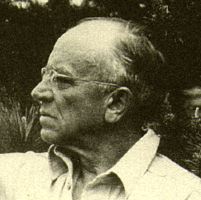In On Being Morally Considerablei, the America philosopher Kenneth E. Goodpaster argues that ethics and morality have to go beyond anthropocentrism, as it is absolutely wrong to think of the environment only in terms of human satisfaction. Any distinction between organisms somehow “worthy” of moral consideration and others that are not is plainly a case of discrimination.
At the end of the first half of the 20th century, the Russian philosopher Piotr Demianovich Ouspensky (1878-1947) theorized that every thing in the universe had a physical or phenomenal aspect and also an invisible or noumenal one. In his view, what the senses couldn’t perceive was a kind of “intellect,” with which all living things, as well as apparently lifeless things, were all equipped.
iIn M.E. Zimmerman et al (edts.), Environmental Philosophy, Prentice Hall, Upper Saddle River, New Jersey, 1998 pp. 56-70, originally published on: Journal of Philosophy, LXXV, 6, 1978 pp. 308-25

fig. 1 Piotr Demianovich Ouspensky
According to Ouspensky, the whole is greater than the sum of the parts. Just as cells living in harmony form a complex living being, so the parts of nature constitute a super-organism of which the inorganic world, such as the earth, water and are, are integral parts. This superorganism is alive, because if it lacked any of its constituent parts it would have ceased to be, just as any living being ceases to live if it loses one of its vital components
(Cfr. R.F.Nash, The Right of Nature, The University of Wisconsin Press Madison, Wisconsin, 1989, p.57.)
fig.2 Aldo Leopold
Aldo Leopold (1887-1947) was inspired by this vision when he wrote A Sand County Almanaci. The chapter in that book on the land ethic is revolutionary: Through the land ethic, man becomes an integral part of nature, which in and of itself has a value unto itself, rather than only having a value for human beings.
One of the environmentalist battles of the 1970s pitted Walt Disney Co. against the Sierra Club organization. The bone of contention was a planned ski resort in the Sierra Nevada mountains, realization of which would have meant the elimination of thousands of trees. The court eventually ruled that the Sierra Club’s client – the trees - did not have “standing,” meaning in legal terms that they had no business appealing to the courts. As it happens, Disney scrapped the project due to the negative publicity around it.
In the aftermath of this case, Christopher Stone, a philosopher of law, wrote an essay titled Should Trees Have Standings?ii exploiting wordplay between the concept of legal rights and an upright position. He argued that in the Sierra Nevada ski resort there was indeed a damaged party. To demonstrate his claim, he noted that his lawn communicated with greater clarity when it needed water, as in fact it began to wilt and die.
Goodpaster claims that plants are an integral part of the Land Ethic, adding that plants are not simply objects but living entities. As they tend to protect and heal themselves, it’s not plausible to deny that trees do not have an interest in remaining alive.
Paul W. Taylor argues that trees, even if they do not have desires or feelings, can be damaged or aided, and that it is our duty to seek their welfare – in the sense that we have prima facie moral obligations towards trees insofar as they are members of the earth’s biotic community, and we are morally bound to them insofar as they participate in keeping ecosystems alive and complete. For Taylor, it is our moral duty to consider as good what is good for them (the trees), and to help them live a healthy existence in a natural state.
H.Rolston III, another environmentalistiii, depicts a plant-organism as a spontaneous system that maintains and reproduces itself and also executes a program. Inside this system there is information that supervises procedures, and without which the organism would be nothing other than some carbon fluff. For Rolston, this information is contained in the DNA sequence and supplies the organism with a telos or end purpose – even if the organism may not be aware of this.
Value, then, is not anthropologically projected onto the object but is already present in the object in a biogenetic sense. So there is no motive to exclude plants from moral consideration.
For Rolston, though, it’s reductive to stop here, because the single plant, conceived as a solitary organism in an inorganic world, could not survive or even live. It would have no value without its surroundings, with which it is engaged in a set of relations. So, he suggests, we have to consider the plant as adapted inside an ecosystem and consider the single organism as a “point of experience” in the network of interconnections between living things. It is this that has intrinsic value per se, and it is this that uses both its own specific techniques and know-how to carry out its life and, at the same time, modify its environment.
So there is something even bigger than the plant or the species that has value: The Ecosystem.
I can’t help but note that a clause in Article 3/5 of the proposed European Union Constitution establishes as a duty for both the Union and the member states the due respect for and consideration of environmental concerns. This orientation suggest that it is both a moral and juridical duty to recognize the protection of the environment, the ecosystem and all living things as one of the “fundamental values” of the Third Millennium.
As living things, plants also have a dignity that must be respected – because after all plants are sensitive, they communicate, they learn, they remember and they plan ahead.
To understand this better, and to demonstrate and communicate it, I project a poetic installation named “TAFKAV” – The Artist Formerly Known As Vanda. It is a tech-noetic and syncretic work that triggers a hermeneutic process between man, technology and nature.
iA. Leopold, A Sand County Almanac, ..., ed. Italiana Red Edizioni Como 1997.
iiStone, Christopher D. 1974. Should Trees Have Standing? Los Altos, CA: William Kaufman Inc.
iiiH. Rolston III Challenges in Environmental Ethics, in: M.E. Zimmerman et al. (edts.), Environmental Philosophy, Prentice Hall, Upper Saddle River, New Jersey, 1998 pp. 124-44, originally published on: Environmental Ethics, vol.2, n.2, 1980







Nessun commento:
Posta un commento